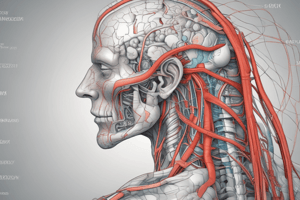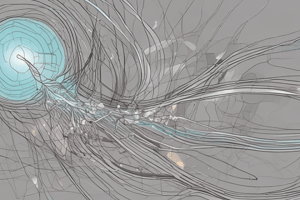Podcast
Questions and Answers
During which phase of an action potential does the membrane potential rapidly increase due to an influx of positively charged ions?
During which phase of an action potential does the membrane potential rapidly increase due to an influx of positively charged ions?
- Depolarization phase (correct)
- Refractory period
- Repolarization phase
- Resting phase
What is the function of terminal buttons in neurons?
What is the function of terminal buttons in neurons?
Release neurotransmitters into the synapse
Dendrites are responsible for carrying the action potential away from the cell body.
Dendrites are responsible for carrying the action potential away from the cell body.
False (B)
Match the following types of neurons with their functions:
Match the following types of neurons with their functions:
The study of the functions and properties of muscle tissue, including contraction and relaxation, is known as _______________________ physiology.
The study of the functions and properties of muscle tissue, including contraction and relaxation, is known as _______________________ physiology.
What is the process by which an action potential triggers muscle contraction?
What is the process by which an action potential triggers muscle contraction?
Electrical synapses use neurotransmitters to transmit information.
Electrical synapses use neurotransmitters to transmit information.
What is the purpose of ion channels in the cell membrane?
What is the purpose of ion channels in the cell membrane?
The study of the electrical properties of cells and tissues, including the generation and transmission of electrical signals, is known as _______________.
The study of the electrical properties of cells and tissues, including the generation and transmission of electrical signals, is known as _______________.
Match the following types of synapses with their descriptions:
Match the following types of synapses with their descriptions:
Flashcards are hidden until you start studying
Study Notes
Action Potential
- Definition: A rapid change in the electrical potential of a cell, typically in excitable tissues such as neurons and muscle cells.
- Characteristics:
- Depolarization: A rapid increase in the membrane potential from a negative to a positive value.
- Repolarization: A rapid decrease in the membrane potential back to a negative value.
- Threshold: The minimum potential required to trigger an action potential.
- Phases:
- Resting phase: The membrane potential is at a stable negative value.
- Depolarization phase: The membrane potential rapidly increases due to an influx of positively charged ions (Na+).
- Repolarization phase: The membrane potential rapidly decreases due to an efflux of positively charged ions (K+).
- Refractory period: A period during which the cell is unable to generate another action potential.
Neurophysiology
- Definition: The study of the functions and properties of neurons, including the generation and transmission of electrical signals.
- Key concepts:
- Dendrites: Receive synaptic inputs from other neurons.
- Cell body: Contains the nucleus and the majority of the cell's organelles.
- Axon: Carries the action potential away from the cell body.
- Terminal buttons: Release neurotransmitters into the synapse.
- Types of neurons:
- Sensory neurons: Transmit information from sensory receptors to the CNS.
- Motor neurons: Transmit information from the CNS to muscles or glands.
- Interneurons: Integrate and process information within the CNS.
Muscle Physiology
- Definition: The study of the functions and properties of muscle tissue, including contraction and relaxation.
- Types of muscle:
- Skeletal muscle: Voluntary muscle that is attached to bones and helps move the body.
- Smooth muscle: Involuntary muscle that is found in the walls of hollow organs and helps move substances through them.
- Cardiac muscle: Involuntary muscle that is found in the heart and helps pump blood.
- Muscle contraction:
- Excitation-contraction coupling: The process by which an action potential triggers muscle contraction.
- Sliding filament theory: The theory that muscle contraction occurs due to the sliding of actin and myosin filaments past each other.
Synaptic Transmission
- Definition: The process by which a neuron transmits information to another neuron or to a muscle or gland cell.
- Steps:
- Neurotransmitter release: The terminal button of the presynaptic neuron releases neurotransmitters into the synapse.
- Neurotransmitter binding: The neurotransmitters bind to receptors on the postsynaptic neuron or muscle cell.
- Postsynaptic potential: The binding of neurotransmitters triggers a change in the postsynaptic membrane potential.
- Integration: The postsynaptic neuron or muscle cell integrates the information from multiple synaptic inputs.
- Types of synapses:
- Chemical synapses: Use neurotransmitters to transmit information.
- Electrical synapses: Use direct electrical connections to transmit information.
Electrophysiology
- Definition: The study of the electrical properties of cells and tissues, including the generation and transmission of electrical signals.
- Techniques:
- Electrophysiology recording: The use of electrodes to record electrical activity from cells or tissues.
- Patch clamp: A technique used to record electrical activity from individual ion channels.
- Concepts:
- Ion channels: Proteins that allow ions to flow across the cell membrane.
- Membrane potential: The electrical potential difference across the cell membrane.
- Electrical conduction: The transmission of electrical signals through tissues.
Action Potential
- Rapid change in electrical potential of a cell, typically in excitable tissues such as neurons and muscle cells.
- Characteristics: depolarization, repolarization, and threshold.
- Phases: resting phase, depolarization phase, repolarization phase, and refractory period.
Phases of Action Potential
- Resting phase: stable negative membrane potential.
- Depolarization phase: rapid increase in membrane potential due to influx of positively charged ions (Na+).
- Repolarization phase: rapid decrease in membrane potential due to efflux of positively charged ions (K+).
- Refractory period: period during which the cell is unable to generate another action potential.
Neurophysiology
- Study of functions and properties of neurons, including generation and transmission of electrical signals.
- Key concepts: dendrites, cell body, axon, and terminal buttons.
- Dendrites receive synaptic inputs from other neurons.
- Cell body contains the nucleus and the majority of the cell's organelles.
- Axon carries the action potential away from the cell body.
- Terminal buttons release neurotransmitters into the synapse.
Types of Neurons
- Sensory neurons: transmit information from sensory receptors to the CNS.
- Motor neurons: transmit information from the CNS to muscles or glands.
- Interneurons: integrate and process information within the CNS.
Muscle Physiology
- Study of functions and properties of muscle tissue, including contraction and relaxation.
- Types of muscle: skeletal muscle, smooth muscle, and cardiac muscle.
- Skeletal muscle: voluntary muscle that is attached to bones and helps move the body.
- Smooth muscle: involuntary muscle that is found in the walls of hollow organs and helps move substances through them.
- Cardiac muscle: involuntary muscle that is found in the heart and helps pump blood.
Muscle Contraction
- Excitation-contraction coupling: process by which an action potential triggers muscle contraction.
- Sliding filament theory: theory that muscle contraction occurs due to the sliding of actin and myosin filaments past each other.
Synaptic Transmission
- Process by which a neuron transmits information to another neuron or to a muscle or gland cell.
- Steps: neurotransmitter release, neurotransmitter binding, postsynaptic potential, and integration.
- Neurotransmitter release: terminal button of the presynaptic neuron releases neurotransmitters into the synapse.
- Neurotransmitter binding: neurotransmitters bind to receptors on the postsynaptic neuron or muscle cell.
- Postsynaptic potential: binding of neurotransmitters triggers a change in the postsynaptic membrane potential.
- Integration: postsynaptic neuron or muscle cell integrates the information from multiple synaptic inputs.
Types of Synapses
- Chemical synapses: use neurotransmitters to transmit information.
- Electrical synapses: use direct electrical connections to transmit information.
Electrophysiology
- Study of electrical properties of cells and tissues, including the generation and transmission of electrical signals.
- Techniques: electrophysiology recording, patch clamp.
- Concepts: ion channels, membrane potential, and electrical conduction.
- Ion channels: proteins that allow ions to flow across the cell membrane.
- Membrane potential: electrical potential difference across the cell membrane.
- Electrical conduction: transmission of electrical signals through tissues.
Studying That Suits You
Use AI to generate personalized quizzes and flashcards to suit your learning preferences.




